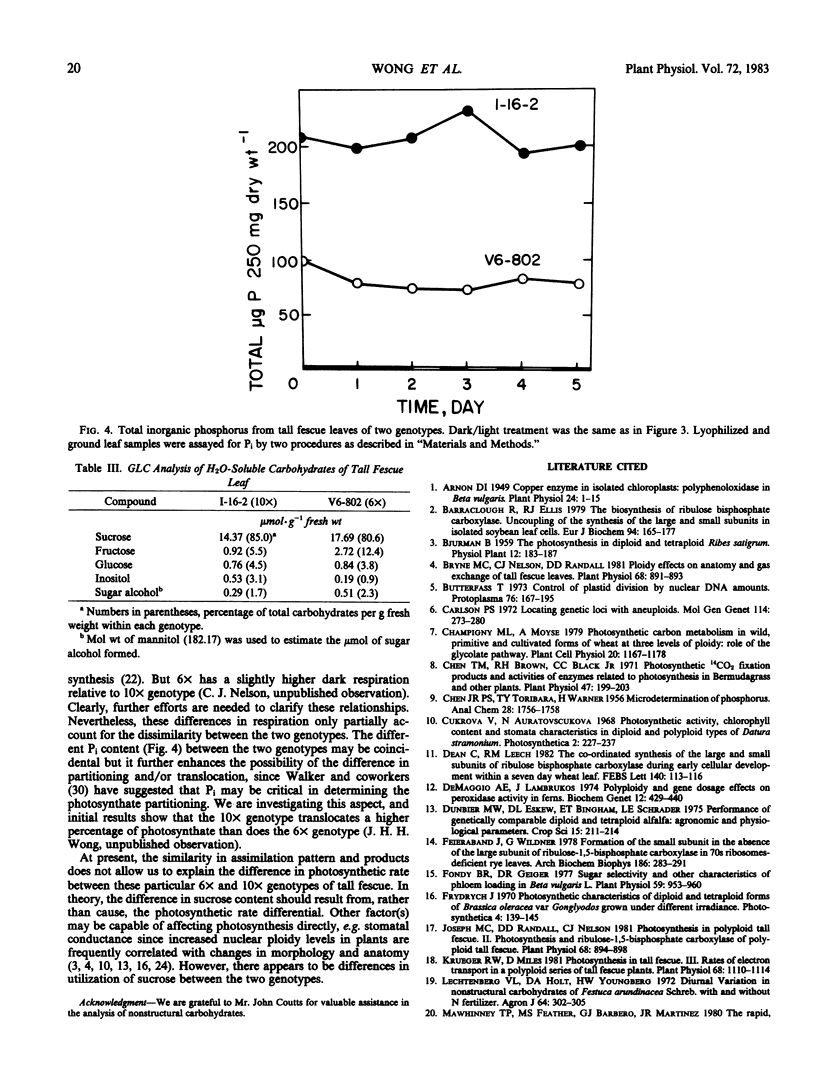Abstract
We previously reported that the net photosynthetic rate of a decaploid genotype (I-16-2) of tall fescue (Festuca arundinacea Schreb.) was 32 to 41 versus 22 milligrams CO2 per square decimeter per hour in a hexaploid genotype (V6-802) (Randall, Nelson, Asay Plant Physiol 59: 38-41). The high rate was later correlated with increases in total ribulose 1,5-bisphosphate carboxylase protein (17%) and activity (27%) (Joseph, Randall, Nelson Plant Physiol 68: 894-898). This report characterizes photosynthesis with respect to light saturation and early products of photosynthesis in an attempt to identify regulatory metabolic site(s) in these two genotypes. Analysis of the early products of photosynthesis indicated that both genotypes fixed CO2 via the Calvin-Benson cycle with phosphoglyceric acid as the initial primary product. Both genotypes had similar 14C-labeled intermediates. Sucrose was the primary sink of 14CO2 assimilation. After 10 min of 14CO2 assimilation with attached leaves, sucrose accounted for 89% (decaploid) and 81% (hexaploid) of the total 14C incorporated. In 10 min, this amounted to 1.3 (decaploid) and 0.8 (hexaploid) μmol [14C]sucrose formed g fresh weight−1 and reflected the observed differences in photosynthetic rates. There was limited labeling of starch (1%) and fructan (1%). Results of total nonstructural carbohydrates and Pi analysis also demonstrated sucrose was the predominant carbohydrate in fescue leaves. Quantitative differences in sucrose and Pi between the two genotypes may reflect changes in partitioning and this possibility is discussed.
Full text
PDF





Selected References
These references are in PubMed. This may not be the complete list of references from this article.
- Arnon D. I. COPPER ENZYMES IN ISOLATED CHLOROPLASTS. POLYPHENOLOXIDASE IN BETA VULGARIS. Plant Physiol. 1949 Jan;24(1):1–15. doi: 10.1104/pp.24.1.1. [DOI] [PMC free article] [PubMed] [Google Scholar]
- Barraclough R., Ellis R. J. The biosynthesis of ribulose bisphosphate carboxylase. Uncoupling of the synthesis of the large and small subunits in isolated soybean leaf cells. Eur J Biochem. 1979 Feb 15;94(1):165–177. doi: 10.1111/j.1432-1033.1979.tb12883.x. [DOI] [PubMed] [Google Scholar]
- Byrne M. C., Nelson C. J., Randall D. D. Ploidy effects on anatomy and gas exchange of tall fescue leaves. Plant Physiol. 1981 Oct;68(4):891–893. doi: 10.1104/pp.68.4.891. [DOI] [PMC free article] [PubMed] [Google Scholar]
- Carlson P. S. Locating genetic loci with aneuploids. Mol Gen Genet. 1972;114(4):273–280. doi: 10.1007/BF00267495. [DOI] [PubMed] [Google Scholar]
- Chen T. M., Brown R. H., Black C. C. Photosynthetic CO(2) Fixation Products and Activities of Enzymes Related to Photosynthesis in Bermudagrass and Other Plants. Plant Physiol. 1971 Feb;47(2):199–203. doi: 10.1104/pp.47.2.199. [DOI] [PMC free article] [PubMed] [Google Scholar]
- Joseph M. C., Randall D. D. Photosynthesis in Polyploid Tall Fescue : II. PHOTOSYNTHESIS AND RIBULOSE-1, 5-BISPHOSPHATE CARBOXYLASE OF POLYPLOID TALL FESCUE. Plant Physiol. 1981 Oct;68(4):894–898. doi: 10.1104/pp.68.4.894. [DOI] [PMC free article] [PubMed] [Google Scholar]
- Krueger R. W., Miles D. Photosynthesis in Fescue : III. RATES OF ELECTRON TRANSPORT IN A POLYPLOID SERIES OF TALL FESCUE PLANTS. Plant Physiol. 1981 Nov;68(5):1110–1114. doi: 10.1104/pp.68.5.1110. [DOI] [PMC free article] [PubMed] [Google Scholar]
- Randall D. D., Nelson C. J., Asay K. H. Ribulose bisphosphate carboxylase: altered genetic expression in tall fescue. Plant Physiol. 1977 Jan;59(1):38–41. doi: 10.1104/pp.59.1.38. [DOI] [PMC free article] [PubMed] [Google Scholar]


